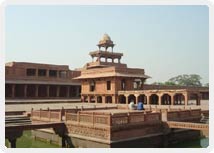+91 858 886 6045
Agra Attractions
The Taj MahalItmad-ud-daulahAgra FortSikandraFatehpur SikriMumtaz MahalTaj MahotsavChini - Ka - RauzaMariyam TombRam BaghThe Octagonal TowerDayal Bagh TempleBuland DarwazaShopping & CuisineFatehpur Sikri Agra

This is another popular attraction of Agra built in the second half of the 16th century by the emperor Akbar. Fatehpur Sikri means the City of Victory was the capital of the Mughal Empire for around 10 years. This city was built in honor of Sufi saint Shaikh Salim Chisti who lived in a cavern on the ridge at Sikri who predicted the birth of Akbar’s son the Jahangir.
This fort is famous for several palatial buildings, royal palaces and courts. The amalgamations of Indian, Persian and Islamic architecture make this fort a grandiose one which was declared an UNESCO World Heritage Site in 1986.
Some of the famous architectural buildings of this fort are:
Diwani-e-Aam
The Diwani-e-Aam (Hall of Public Audience) is the place where the emperor with his officials hears the petitions of public. The hall is famous for its paved courtyard known as the Pachisi. It was where the monarch played chaubar, a game that closely resembles chess using slave girls as pieces.
Diwani-e-Khaas
It is the Hall of Private Audience where the emperor debated various issues with noted theologians. The hall was used for the private meetings by emperors where he discusses issues related to his governance. This is a plain square building with four chhatris on the roof. The central pillar has a square base and an octagonal shaft carved with bands of geometric and floral designs and thirty-six serpentine brackets support a circular platform are the foremost attraction of this building.
This 54 meter high stupendous piece of architecture is the largest of gateways in the world. It is the triumphal arch commissioned by the Mughal Emperor Akbar, when he defeated the king of Khandesh or Gujarat in 1573. This gate is made up of red sandstone and inscribed with Quranic verses, calligraphic and cenotaph.
Palace of Jodha Bai
It is the grandest of all palaces in Fatehpur Sikri dedicated to Akbar's wife Jodha Bai. The architecture of the building is a blend of styles with Hindu columns and Muslim cupolas. This palace is the largest and the most important part of the royal harem.
Panch Mahal
This is a five-storied pavilion of winds in decreasing order. It is known for 176 carved columns. Each floor is supported on pillars and renowned for its intricate jali screens between the pillars. The pavilion was originally used by the women of the royal household and ladies of the harem.
Tomb of Seikh Salim Chisti
It is a marvel tomb inside the Fatehpur Sikri which was built by Mughal Emperor Akbar in honor of the Saint Seikh Salim Chisti whose blessings gave him three sons. The tomb is single story structure built around a central square chamber famous for ornate wooden canopy encrusted with mother-of-pearl mosaic.
Naubat Khana
It is also known as Naqqar Khana meaning a drum house, where a musician used drums to announce the arrival of the Emperor. It is situated ahead of the Hathi Pol Gate or the Elephant Gate, the south entrance to the complex.
Jami Masjid (Jama Masjid)
It is a Jami Mosque meaning the Friday Mosque was built in 1571 AD. It is known for the row of chhatri atop the building. There are three mihrabs in each of the seven bays, while the large central mihrab is covered by a dome decorated with white inlay in geometric patterns.
Anup Talao
This is an ornamental pool with a central platform and four bridges leading up to it. Some of the important buildings of the royal enclave encircle this pool are Khwabgah (House of Dreams) Akbar's residence, Panch Mahal, a five-storey palace, Diwan-i-Khas (Hall of Private Audience), Ankh Michauli and the Astrologer's Seat.
Timing
Open on all days from sunrise to sunset
Entry Fees
Foreigners: Rs 485/-
Indians: INR Rs 50/-
Tajmahal Tours
Golden Triangle India
- Golden Triangle with Corbett
- Golden Triangle with Goa
- Golden Triangle with Kathmandu
- Golden Triangle with Wildlife
- Indian Heritage Tour with Tajmahal
- Buddhist Pilgrimage with Golden Griangle Tour
- Golden Triangle Tour
- Golden Triangle Tour with Haridwar and Rishikesh
- Golden Triangle with Khajuraho Varanasi
- Golden Triangle with Kashmir
- Tajmahal with Pushkar Fair
Delhi Tourism
Jaipur Tourism
Agra Tourism
Golden Triangle Extension
- Ranthambhor National Park
- Khajuraho Tourism
- Varanasi Tourism
- Rishikesh Tourism
- Haridwar Tourism
- Corbett Wildlife Sanctuary
- Mathura Travel
- Vrindavan Travel
- Gwalior Travel
Activities to Do


Copyright © 2020, www.tajmahal-india-tours.com
Recognized by Ministry of Tourism, Government of India
National Tourism Award Winner
Powered by SOFTTIX

